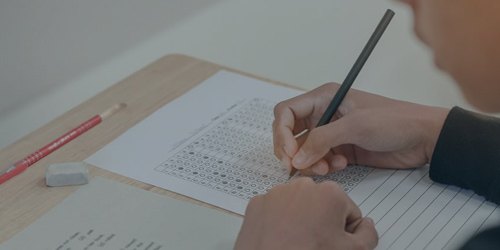KIITEE 2022 Syllabus:
The students appearing for the KIITEE 2022 entrance exam are advised to go through the syllabus thoroughly before starting their preparation for the exam. Candidates must have also knowledge about KIITEE Pattern and KIITEE schedules. The exam will mostly cover the subjects from Physics, Chemistry, Mathematics. The students can get the detailed syllabus below -
Physics:
Unit 1: Units and Measurement
Units for measurement, system of units-S.I., fundamental and derived units. Dimensions and their applications
Unit 2: Description of Motion in One Dimension
Motion in a straight line, uniform and non-uniform motion, their graphical representation. Uniformly accelerated motion, and its application.
Unit 3: Description of Motion in Two and Three Dimensions
Scalars and vectors, vector addition, a real number, zero vector and its properties. Resolution of vectors. Scalar and vector products, uniform circular motion and its applications projectile motion.
Unit 4: Laws of Motion
Force and inertia Newton’s Laws of Motion. Conservation of linear momentum and its applications, rocket propulsion, friction-laws of friction.
Unit 5: Work, Energy and Power
Concept of work, energy and power. EnergyKinetic and potential. Conservation of energy and its applications, Elastic collisions in one and two dimensions. Different forms of energy
Unit 6: Rotational Motion and Moment of Inertia
Centre of a mass of a two-particle system. Centre of a mass of a rigid body, general motion of a rigid body, nature of rotational motion, torque, angular momentum, its conservation and applications. Moment of inertia, parallel and perpendicular axes theorem, expression of a moment of inertia for the ring, disc and sphere.
Unit 7: Gravitation
Acceleration due to gravity, one and two-dimensional motion under gravity. The universal law of gravitation, variation in the acceleration due to the gravity of the earth. Planetary motion, Kepler’s laws, artificial satellite-geostationary satellite, gravitational potential energy near the surface of the earth, gravitational potential and escape velocity.
Unit 8: Solids and Fluids
Inter-atomic and Inter-molecular forces, states of matter.
- Solids: Elastic properties, Hook’s law, Young’s modulus, bulk modulus, modulus of rigidity.
- Liquids: Cohesion and adhesion. Surface energy and surface tension. The flow of fluids, Bernoulli’s theorem and its applications. Viscosity, Stoke’s Law, terminal velocity.
Unit 9: Oscillations
Periodic motion, simple harmonic motion and its equation of motion, energy in S.H.M., Oscillations of a spring and simple pendulum.
Unit 10: Waves
Wave motion, speed of a wave, longitudinal and transverse waves, superposition of waves, progressive and standing waves, free and forced Oscillations, resonance, a vibration of strings and air columns, beats, Doppler effects.
Unit 11: Heat and Thermodynamics
Thermal expansion of solids, liquids and gases and their specific heats, Relationship between Cp and Cv for gases, the first law of thermodynamics, thermodynamic processes. The second law of thermodynamics, Carnot cycle efficiency of heat engines.
Unit 12: Transference of Heat
Modes of transference of heat. Thermal conductivity. Black body radiations, Kirchoff’s Law, Wien’s law, Stefan’s law of radiation and Newton’s law of cooling.
Unit 13: Electrostatics
Electric charge-its unit and conservation, Coulomb’s law, dielectric constant, electric field, lines of force, field due to dipole and its behaviour in a uniform electric field, electric flux, Gauss’s theorem and its applications. Electric potential, potential due to a point charge. Conductors and insulators, distribution of charge on conductors. Capacitance, parallel plate capacitor, the combination of capacitors, the energy of the capacitor.
Unit 14: Current Electricity
Electric current and its unit, sources of energy, cells-primary and secondary, a grouping of cells resistance of different materials, temperature dependence, specific resistivity, Ohm’s law, Kirchoff’s law, series and parallel circuits. Wheatstone Bridge with their applications and potentiometer with their applications.
Unit 15: Thermal and Chemical Effects of Currents
Heating effects of current, electric power, the simple concept of thermo-electricity- Seeback effect and thermocouple, Chemical effect of currentFaraday’s laws of electrolysis
Unit 16: Magnetic Effects of Currents
Oersted’s experiment, Bio-Savert’s law, magnetic field due to straight wire, circular loop and solenoid, force on a moving charge in a uniform magnetic field ( Lorentz force), force and torques on currents in a magnetic field, force between two current-carrying wires, moving coil galvanometer and conversion to ammeter and voltmeter.
Unit 17: Magneto Statics
Bar magnet, magnetic field, lines of force, torque on a bar magnet in a magnetic field, earth’s magnetic field, para, dia and ferromagnetism, magnetic induction, magnetic susceptibility.
Unit 18: Electromagnetic Induction and Alternating Currents
Induced e.m.f., Faraday’s Law, Lenz’s Law, Self and Mutual Inductance, alternating currents, impedance and reactance, power in a.c. Circuits with L.C. And R Series Combination, resonant circuits. Transformer and A.C. generator.
Unit 19: Ray Optics
Reflection and refraction of light at plane and curved surfaces, total internal reflection, optical fibre; deviation and dispersion of light by a prism; Lens formula, magnification and resolving power, microscope and telescope.
Unit 20: Wave Optics
Wave nature of light; Interference- Young’s double-slit experiment. Diffraction-diffraction due to a single slit. Elementary idea of polarization.
Unit 21: Electromagnetic Waves
Electromagnetic waves and their characteristics, Electromagnetic wave spectrum from gamma to radio waves-propagation of EM waves in the atmosphere.
Unit 22: Electron and Photons
Charge on an electron, e/m for an electron, photoelectric effect and Einstein’s equation of photoelectric effect.
Unit 23: Atoms, Molecules and Nuclei
Alpha particles scattering experiment, Atomic masses, size of the nucleus; radioactivity; Alpha, beta and gamma particles/rays and their properties, radioactive decay law, half-life and mean the life of radioactive nuclei, binding energy, mass-energy relationship, nuclear fission and nuclear fusion.
Unit 24: Solids and Semi-Conductors Devices
Energy bands in solids, conductors, insulators and semiconductors, PN junction, diodes, diode as rectifier, transistor action, transistor as an amplifier.
Chemistry:
Unit 1: Some Basic Concepts
Measurement in chemistry (Precision, significant figures, S.I. units, Dimensional analysis). Laws of chemical combination. Atomic Mass, Molecular Mass, mole concept, Molar Mass, determination of Molecular formula. Chemical equation, the stoichiometry of Chemical reactions.
Unit 2: States of Matter
Gaseous state, measurable properties of gases, Boyle’s Law, Charle’s Law and absolute scale of temperature, Avogadro’s hypothesis, ideal gas equation, Dalton’s law of partial pressures.
Kinetic molecular theory of gases (the microscopic model of gas), deviation from ideal behaviour.
The solid state (classification of solids, X-ray studies of crystal lattices and unit cells, packing of constituent particles in crystals). Imperfection in solids, electrical, magnetic and dielectic properties of solids. Liquid state (Properties of liquids, Vapour pressure, Surface tension, Viscosity).
Unit 3: Atomic Structure
Constituents of the atom (discovery of electron, rutherford model of the atom). Electronics structure of atoms-nature of light and electromagnetic waves, atomic spectra, bohr’s model of hydrogen, shortcomings of the bohr model. Dual nature of matter and radiation. de-Broglie relation. The uncertainty principle, Quantum Mechanical Model of the atom, Orbitals and Quantum numbers. Shapes of orbitals. Aufbau principle, Pauli Exclusion principle, Hund’s Rule, Electronics Configuration of atoms.
Unit 4: Solutions
Types of solutions, Units of concentration, Vapour-pressure of solutions and Raoult’s law. Colligative properties. Determination of molecular mass. Non-ideal solutions and abnormal molecular masses. Volumetric analysis-concentration unit.
Unit 5: Chemical Energetics and Thermodynamics
Energy changes during a chemical reaction, Internal energy and Enthalpy, Internal energy and Enthalpy changes, Origin of Enthalpy change in a reaction, Hess’s Law of constant heat summation, numericals based on these concepts. Enthalpies of reactions (Enthalpy of neutralization, Enthalpy of combustion, Enthalpy of fusion and vaporization).
Sources of energy (conservation of energy sources and identification of alternative sources, pollution associated with consumption of fuels. The sun as the primary source).
First law of thermodynamics; Relation between Internal energy and Enthalpy, application of first law of thermodynamics. Second law of thermodynamics: Entropy, Gibbs energy, Spontaneity of a chemical reaction, Gibbs energy change and chemical equilibrium, Gibbs energy available for useful work.
Unit 6: Chemical Equilibrium
Equilibria involving physical changes (solidliquid, liquid-gas equilibrium involving dissolution of solids in liquids, gases in liquids, general characteristics of equilibrium involving physical processes)
Equilibria involving chemical systems (the law of chemical equilibrium, the magnitude of the equilibrium constant, numerical problems).
Effect of changing conditions of systems at equilibrium (change of concentration, change of temperature, effect of catalyst-Le Chateliar’s principle).
Equilibria involving ions- ionization of electrolytes, weak and strong electrolytes, acidbase equilibrium, various concepts of acids and bases, ionization of water, pH scale, solubility product, numericals based on these concepts.
Unit 7: Redox Reactions and Electrochemistry
Oxidation and reduction as an electron transfer concept. Redox reactions in aqueous solutionselectrochemical cells. e.m.f. of a galvanic cell. Dependence of e.m.f. on concentration and temperature (NERNST). equation and numerical problems based on it .Electrolysis, Oxidation number (rules for assigning oxidation number, redox reactions in terms of oxidation number, nomenclature). Balancing of oxidation-reduction equations.
Electrolytic conduction. Molar conductivity, Kohlrausch’s Law and its applications, Voltaic cell, Electrode potential and Electromotive force, Gibb’s energy change and cell potential. Electrode potential and products of electrolysis, Fuel cells, corrosion and its prevention.
Unit 8: Rates of Chemical Reactions and Chemical Kinetics
Rate of reaction, Instantaneous rate of reaction and order of reaction. Factors affecting rates of reactions- factors affecting rate of collisions encountered between the reactant molecules, effect of temperature on the reaction rate, concept of activation energy catalyst. Effect of light of rates of reactions. Elementary reactions as steps to more complex reactions. How fast are chemical reactions?
Rate law expression. Order of a reaction (with suitable examples).Units of rates and specific rate constant. Order of reaction and effect of concentration (study will be confined to first order only). Temperature dependence of rate constant – Fast reactions (only elementary idea). Mechanism of reaction (only elementary idea). Photochemical reactions.
Unit 9: Surface Chemistry
Surface: Adsorption – physical and chemical adsorption, adsorption isotherms.
Colloids-Preparation and general properties, Emulsions, Micelles.
Catalysis: Homogeneous and heterogeneous, the structure of catalyst, Enzymes, Zeolites.
Unit 10: Chemical Families Periodic Properties
Modern periodic law, Types of elements – Representatives elements (s & p block, Transition elements – d-block elements, inner transition elements-f-block elements. Periodic trends in properties-ionization enthalpy, electron gain enthalpy, atomic radii, valence, periodicity in properties of compounds).
Unit 11: Chemical Bonding and Molecular Structure
Chemical bonds and Lewis structure, shapes of molecules ( VSEPR theory), Quantum theory of the covalent bond, hydrogen and some other simple molecules, carbon compounds, hybridization, Boron and Beryllium compounds.
A coordinate covalent bond, ionic bond as an extreme case of a polar covalent bond, ionic character of molecules and polar molecules. Bonding in solid-state ionic, molecular and covalent solids, metals. Hydrogen bond, Resonance.
Molecules: Molecular orbital. Theory-bond order and magnetic properties of H2,O2,N2,F2 on the basis of MOT. Hybridisation involving s, p and d orbitals (including shapes of simple organic molecules), Dipole moment and structure of molecules
Unit 12: Chemistry of Non-Metals - 1
Hydrogen (unique position in the periodic table, occurrence, isotopes, properties, reactions and uses), Hydrides-molecular, soline and interstitial
Oxygen (occurrence, preparation, properties and reactions, uses),simple oxides; ozone
Water and hydrogen peroxide, structure of water molecule and its aggregates, physical and chemical properties of water, hard and soft water, water softening, hydrogen peroxidepreparation, properties, structure and uses.
Nitrogen- Preparation, properties, uses, compounds of Nitrogen-Ammonia, Oxides of Nitrogen, Nitric Acid-preparation, properties and uses.
Unit 13: Chemistry of Non-metals-II
Boron-occurrence, isolation, physical and chemical properties, borax and boric acid, uses of boron and its compounds.
Carbon, inorganic compounds of carbon-oxides, halides, carbides, elemental carbon.
Silicon- occurrence, preparation and properties, oxides and oxyacids of phosphorus, chemical fertilizers.
Sulphur – occurrence and extraction, properties and reactions, oxides, Sulphuric acid – preparation, properties and uses, sodium thiosulphate.
Halogens- occurrence, preparation, properties, hydrogen halides, uses of halogens.
Noble gases- discovery, occurrence and isolation, physical properties, the chemistry of noble gases and their uses.
Unit 14: Chemistry of Lighter Metals
Sodium and Potassium- occurrence and extraction, properties and uses. Important compounds-NaCl, Na2CO3, NaHCO3, NaOH, KCI, KOH.
Magnesium and calcium-occurrence and extraction, properties and uses. Important compounds Mgcl2, MgSO4, CaO, Ca(OH)2, CaCO3, CaSO4, Plaster of paris, Bleaching Powder.
Aluminium – occurrence, extraction properties and uses, compounds-AlCI3, alums.
Cement. Biological role of Sodium, Potassium, Magnesium and Calcium.
Unit 15:- Heavy Metals
Iron – Occurrence and extraction, compounds of iron, oxides, halides, sulphides, sulphate, alloy and steel.
Copper and Silver- occurrence and extraction, properties and uses, compounds-sulphides, halides and sulphates, photography.
Zinc and Mercury- occurrence and extraction, properties and uses, compounds-oxides, halides; sulphides and sulphates.
Tin and Lead- occurrence and extraction, properties and uses, compounds-oxides, sulphides, halides.
Unit 16: Chemistry of Representative Elements
Periodic properties- Trends in groups and periods (a) Oxides-nature (b) Halides-melting points (c) Carbonates and sulphates-solubility.
The chemistry of s and p block elements, electronics configuration, general characteristic properties and oxidation states of the following:-
Group 1 elements - Alkali metals
Group 2 elements - Alkaline earth metals
Group 13 elements - Boron family
Group 14 elements - Carbon family
Group 15 elements - Nitrogen family
Group 16 elements - Oxygen family
Group 17 elements - Halogen family
Group 18 elements - Noble gases & Hydrogen
Unit 17: Transition Metals Including Lanthanides
Electronic configuration: General characteristic properties, oxidation states of transition metals. First-row transition metals and general properties of their compounds-oxides, halides and sulphides.
General properties of a second and third-row transition elements (Groupwise discussion).
Preparation and reactions, properties and uses of Potassium dichromate Potassium permanganate.
Inner Transition Elements: General discussion with special reference to oxidation states and lanthanide contraction
Unit 18: Coordination Chemistry and Organo Metallics
Coordination compounds, Nomenclature: Isomerism in coordination compounds; Bonding 16 in coordination compounds, Werner’s coordination theory. Applications of coordination compounds.
Unit 19: Nuclear Chemistry
Nature of radiation from radioactive substances. Nuclear reactions; Radio-active disintegration series; Artificial transmutation of elements; Nuclear fission and Nuclear fusion: Isotopes and their applications: Radio carbon-dating.
Unit 20: Purification and Characterisation of Organic Compounds
Purification (crystallization, sublimation, distillation, differential extraction, chromatography).
Qualitative analysis, detection of nitrogen, sulphur, phosphorus and halogens.
Quantitative analysis- estimation of carbon, hydrogen, nitrogen, halogens, sulphur, phosphorus ( basic principles only)
Determination of molecular mass-Silver salt method, cholroplatinate salt method
Calculation of empirical formula and molecular formula.
Numerical problems in organic quantitative analysis, modern methods of structure elucidation.
Unit 21: Some Basic Principles
Classification of Organic Compounds.
Tetravalency of Carbon, Homologous series. Functional groups- - C=C-,-C C-, and groups containing halogen, oxygen, nitrogen and sulphur. General introduction to naming organic compounds-Common names and IUPAC nomenclature of aliphatic, aromatic and Cyclic Compounds. Illustration with examples of Compounds having not more than three same or different functional groups/ atoms. IsomerismStructural and stereoisomerism (geometrical and optical). Chirality-Isomerism in Compounds having one and two chiral Centres. Enantiomers, diastereoisomers, recemic forms, racemisation & resolution. Covalent bond fission-Homolytic and Heterolytic: free radicals carbocations and carbanions. Stability of Carbocations and free-radicals. Electrophiles and Nucleophiles. Electron displacement in a covalent bone inductive effect, electromeric effect, resonance Common types of organic reactions substitutions, addition, elimination and rearrangement reactions. Illustration with examples.
Unit 22: Hydrocarbons
Classification. Sources of hydrocarbons:
Alkanes- General methods of preparation (from unsaturated hydrocarbons, alkyl halides, aldehydes, ketones and carboxylic acids). Physical properties and reactions (Substitution), Oxidation and miscellaneous). Conformations of alkanes (ethane, propane-butane) and cyclohexane, sawhorse and Newman projections)-mechanism of halogenation of alkanes.
Alkanes and Alkynes- General methods of preparation physical properties, Chemical reactions-Mechanism of electrophilic addition reactions in alkenes-Markowni Koff’s Rule, peroxide effect. Acidic character of alkynes. The polymerisation of alkenes.
Aromatic hydrocarbons- Benzene and its homologues, Isomerism, Chemical reactions of benzene. Structure of benzene, resonance. Directive influence of substituents.
Petroleum – Hydro Carbons from Petroleum, Cracking and reforming, quality of gasoline octane number, gasoline additives.
Unit 23: Organic Compound Containing Halogens
(Haloalkanes and Haloarenes) Methods of preparation, physical properties and reactions. Preparation, properties and uses of Chloroform and lodoform.
Unit 24: Organic Compounds Containing Oxygen
General methods of preparation, correlation of physical properties with their structures, chemical properties and uses of Alcohols, polyhydric alcohols, Ethers, aldehydes, ketones, 17 carboxylic acids and their derivatives, Phenol, Benzaldehyde and Benzoic acid -their important methods of preparation and reactions. The acidity of carboxylic acids and phenol effect of substituents on the acidity of carboxylic acids.
Unit 25: Organic Compounds Containing Nitrogen
(Cyanides, isocyanides, nitrogen compounds and amines)
Nomenclature and classification of amines, cyanides, isocyanides, nitro compounds and their methods of preparation; correlation of their physical properties with structure, chemical reactions and uses- Basicity of amines.
Unit 26: Synthetic and Natural Polymers
Classification of Polymers, natural and synthetic polymers (with stress on their general methods of preparation) and important uses of the following.
Teflon, PVC, Polystyrene, Nylon-66, terylene, Bakelite)
Unit 27: Bio-Molecules and Biological Processes
The Cell and Energy Cycle
Carbohydrates: Monosaccharides, Disaccharides, Polysaccharides
Amino acids and Peptides- Structure and classification.
Proteins and Enzymes-Structure of Proteins, Role of enzymes.
Nucleic Acids-DNA and RNA
Biological functions of Nucleic acids-Protein synthesis and replication.
Lipids – Structure, membranes and their functions.
Unit 28: Chemistry In Action
Dyes, Chemicals in medicines (antipyretic, analgesic, antibiotics & tranquilisers), Rocket propellants.
( Structural formulae non-evaluative)
Unit 29: Environmental Chemistry
Environmental pollutants; soil, water and air pollution; major atmospheric pollutants; acid rain, Ozone and its reactions causing ozone layer depletion, effects of the depletion of the ozone layer, industrial air pollution.
Mathematics:
Unit 1:- Sets, Relations and Functions
Sets and their Representations, Union, intersection and complements of sets, and their algebraic properties, Relations, equivalence relations, mappings, one-one, into and onto mappings, composition of mappings.
Unit 2: Complex Numbers
Complex numbers in the form a+ib and their representation in a plane. Argand diagram. Algebra of complex numbers, Modulus and Argument (or amplitude) of a complex number, square root of a complex number. Cube roots of unity, triangle inequality.
Unit 3: Matrices and Determinants
Determinants and matrices of order two and three, properties of determinants, Evaluation of determinants. Area of triangles using determinants; Addition and multiplication of matrices, adjoint and inverse of the matrix. Test of consistency and solution of simultaneous linear equations using determinants and matrices.
Unit 4: Quadratic Equations
Quadratic equations in real and complex number system and their solutions. Relation between roots and co-efficients, nature of roots, formation of quadratic equations with given roots; Symmetric functions of roots, equations 18 reducible to quadratic equations-application to practical problems.
Unit 5 : Permutations and Combinations
Fundamental principle of counting; Permutation as an arrangement and combination as selection, Meaning of P (n,r) and C (n,r). Simple applications.
Unit 6: Binomial Theorem and Its Applications
Binomial Theorem for a positive integral index; general term and middle term; Binomial
Theorem for any index. Properties of Binomial Co-efficients. Simple applications for approximations.
Unit 7: Sequences and Series
Arithmetic, Geometric and Harmonic progressions. Insertion of Arithmetic Geometric and Harmonic means between two given numbers. Relation Between A.M., G.M. and H.M. Special series: Sn, Sn2, Sn3 . ArithmeticoGeometric Series, Exponential and Logarithmic series.
Unit 8: Differential Calculus
Polynomials, rational, trigonometric, logarithmic and exponential functions, Inverse functions. Graphs of simple functions. Limits, Continuity; differentiation of the sum, difference, product and quotient of two functions: differentiation of trigonometric, inverse trigonometric, logarithmic, exponential, composite and implicit functions; derivatives of order up to two. Applications of derivatives: Rate of change of quantities, monotonic-increasing and decreasing functions, Maxima and minima of functions of one variable, tangents and normals, Rolle’s and Lagrange’s Mean Value Theorems.
Unit 9:- Integral Calculus
Integral as an anti-derivative. Fundamental integrals involving algebraic, trigonometric, exponential and logarithmic functions. Integration by substitution, by parts and partial fractions. Integration using trigonometric identities. Integral as limit of a sum. Properties of definite integrals. Evaluation of definite integrals; Determining areas of the regions bounded by simple curves.
Unit 10:- Differential Equations
Ordinary differential equations, their order and degree. Formation of differential equations. A solution of differential equations by the method of separation of variables. The solution of homogeneous and linear differential equations, and those of the type
d2y/dx2 = f(x)
Unit 12:- Two Dimensional Geometry
Recall of Cartesian system of rectangular coordinates in a plane, distance formula, area of a triangle, condition of the collinearity of three points and section formula, centroid and incentre of a triangle, locus and its equation, translation of axes, slope of a line, parallel and perpendicular lines, intercepts of a line on the coordinate axes.
The straight line and pair of straight lines
Various forms of equations of a line, intersection of line, angles between two lines, conditions for concurrence of three lines, distance of a point from a line Equations of internal and external bisectors of angles between two lines, coordinates of centroid, orthocenter and circumcentre of a triangle, equation of family of lines passing through the point of intersection of two lines, homogeneous equation of second degree in x and y, angle between pair of lines through the origin, combined equation of the bisectors of the angles between a pair of lines, condition for the general second-degree equation to a represent a pair of lines, point of intersection and angle between two lines.
Circles and Family of Circles
Standard form of equation of a circle, general form of the equation of a circle, its radius and centre, equation of a circle in the parametric form, equation of a circle when the endpoints of a diameter are given, points of intersection of a 19 line and a circle with the centre at the origin and conditions for a line to be tangent to the circle, length of the tangent, equation of the tangent, equation of a family of circles through the intersection of two circles, condition for two intersecting circles to be orthogonal.
Conic Sections
Sections of cones, equations of conic sections (parabola, ellipse and hyperbola) in standard forms, condition for y = mx+c to be a tangent and point (s) of tangency
Unit 13: Three Dimensional Geometry
Coordinates of a point in space, the distance between two points; Section formula, direction ratios and direction cosines, angle between two intersecting lines. Skew lines, the shortest distance between them and its equation. Equations of a line and a plane in different forms; the intersection of a line and a plane, coplanar lines, equation of a sphere, its centre and radius. Diameter form of the equation of a sphere.
Unit 14: Vector Algebra
Vectors and Scalars, the addition of vectors, components of a vector in two dimensions and three-dimensional space, scalar and vector products, scalar and vector triple product. Application of vectors to plane geometry.
Unit 15: Measures of Central Tendency and Dispersion
Calculation of Mean, median and mode of grouped and ungrouped data. Calculation of standard deviation, variance and mean deviation for grouped and ungrouped data.
Unit 16: Probability
Probability of an event, addition and multiplication theorems of probability and their application; Conditional probability; Bayes’ Theorem, the probability distribution of a random variate; Binomial and Poisson distributions and their properties.
Unit 17: Trigonometry
Trigonometrical identities and equations. Inverse trigonometric functions and their properties. Properties of triangles, including centroid, incentre, circum-centre and orthocenter, solution of triangles. Heights and Distances.
Syllabus for KIITEE 2021 that BTech (Lateral Entry) aspirants:
Mathematics:
Unit 1: Ordinary Differential Equation
The differential equation of first order. The linear differential equation of second order (homogeneous and nonhomogeneous case). Cauchy, Euler’s equation, Application of first-order differential equations (mixture problem, Newton’s law of cooling, orthogonal trajectory). Application to LCR circuits, Application to free and forced vibration of Mass spring system.
Unit 2: Series Method
Properties of power series, Radius of convergence of power series, Legender’s equation and Legender’s polynomial, properties of Legender’s polynomial, Gamma function, ordinary and singular point Frobenius method, Bessel’s equation and properties of Bessel’s function.
Unit 3: Laplace Transform
Laplace transforms of standard function, periodic functions, Unit step function, Transforms of derivatives and integrals. Differentiation and integration of transforms, Linearity property, Inverse Laplace transform, Shifting theorems, Convolution. Application to solve differential and integral equations (initial value problem).
Unit 4: Fourier Series
Periodic function, Fourier series, Euler’s formula, Even and odd functions, Fourier series expansions of even and odd function, Half range expansion of functions, Expansion of functions with finite discontinuities.
Unit 5: Matrix
Types of matrices, algebra of matrices, rank, solution of a non-homogenous system of equations, consistency of the system of equations, Linear dependence and independance, solution of a homogeneous system of equation. Eigen values and eigenvectors. Norm and inner product. Orthogonal and projection matrix. Application of eigen values and vectors to solve the system of the homogeneous linear differential equation.
Unit 6: Vectors
Vector algebra, the product of vectors, vector differentiation, vector differential operator, gradient, directional derivatives, divergence, curl, line integral, double integral, green’s theorem.
Engineering Mechanics:
Unit 1: Statics
Conditions of equilibrium, the concept of free body diagram, methods of moments and solution to engineering problems.
Friction: Static friction, ladder friction, problems with friction, Belt friction and screw jack, force analysis of plane trusses (method of joint, method of sections, plane frames, methods of members), Parallel forces in a plane, Centre of parallel forces, Pappus Guldinus theorems, MI of plane figures, parallel axis theorem, perpendicular axis theorem, Polar MI, Principle of virtual work for a single particle, rigid bodies, ideal systems and constrained bodies.
Unit 2: Dynamics
Force proportional to displacement, free vibration, D’ Alembert’s principle, momentum and impulse. Application to the principle of linear momentum to a single particle, rigid bodies and ideal systems. Application to the principle of angular momentum to a single particle and rotating rigid bodies. Principle of conservation of momentum.
Unit 3: Work and Energy
Principle of work and energy for an ideal system, Conservation of energy.
Basic Electrical Engineering:
Unit 1: Electrostatics
Coulomb’s law, Electric charge, Potential, Field & Capacitance, Potential gradient due to spherical cylindrical and plane charges, Electric force, Flux density and sensitivity. Calculation of Capacitance of spherical, coaxial, cylindrical and parallel plate condenser. Energy stored in an electric field.
Unit 2: Electromagnetism
Magnetic field due to current in the conductor. Magnetic field intensity and Flux density. Permeability, B-H curves, Magnetisation, Concept in hysteresis. Magnetomotive force and Magnetic reluctance.
Electrodynamic force:- Faraday’s law of electromagnetic induction, Eddy current, emf induced in a conductor moving in a magnetic field. Energy stored in a magnetic field.
Unit 3: D.C. Circuit
Current distribution in series and parallel circuit. Power and energy in the electric circuit. Star-Delta conversion. Kirchoff's law & its application and solve electric circuit by branch & loop current method & nodal method. Superposition theorem.
Unit 4: A.C. Circuit
Production of alternating current – Instantaneous, average & RMS value of current and voltage. Peak factor, Form factor, Amplitude, Frequency, Phase difference, Addition and subtraction of alternating quantity. Phasor diagram, Resistance, Inductance, Capacitance, impedance and admittance- power and power factor-series and parallel circuits. Q factor-Three phase circuit. Star-Delta connection-Active and reactive power. Power measurement with one and two wattmeter methods-Calculation in RLC circuit, in the series circuit.
Unit 5: Instrument
Construction and principle of operationPMMC, MI and dynamometer type ammeter, voltmeter and dynamometer type wattmeter. Power factor meter.
Unit 6: Illumination
Law of illumination- Solid angle, Luminous flux, Luminous intensity, illumination brightness and luminous efficiency.
Unit 7: Production Light
Filament lamp, Arc lamp, Electric discharge lamps, Sodium vapour lamp, Mercury vapour lamp-Theory of electrical energy radiation. Comparison between filament lamp and fluorescent lamp.
Energy bands in solids, conductors, insulators and semiconductors, PN junction, diodes, diode as rectifier, transistor action, transistor as an amplifier.











